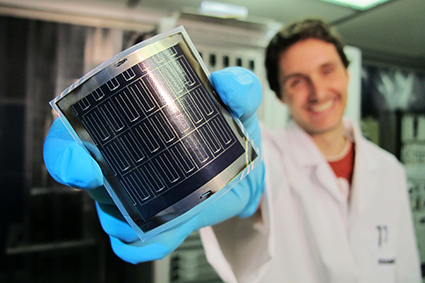Empa breaks world efficiency record for thin-film solar PV
 The quest to make the best, most efficient photovoltaics has inspired an international, fast-moving race, with winners (albeit temporarily) taking on distinct categories. Most recently the CIGS (copper indium gallium diselenide), thin-film record was taken over by Empa, the Swiss Federal Laboratories for Materials Science and Technology. Their flexible CIGS thin-film PV, as verified by Germany’s Fraunhofer Institute for Solar Energy Systems (ISE), reached an efficiency level of 20.4 percent, putting their technology on par with the more popular silicon PVs that dominate installations the world over.
The quest to make the best, most efficient photovoltaics has inspired an international, fast-moving race, with winners (albeit temporarily) taking on distinct categories. Most recently the CIGS (copper indium gallium diselenide), thin-film record was taken over by Empa, the Swiss Federal Laboratories for Materials Science and Technology. Their flexible CIGS thin-film PV, as verified by Germany’s Fraunhofer Institute for Solar Energy Systems (ISE), reached an efficiency level of 20.4 percent, putting their technology on par with the more popular silicon PVs that dominate installations the world over.
CIGS is an alternative to the more popular silicon PV modules because production costs less, since they use less materials, less expensive materials and can have more applications, like being flexible as the new Empa cells are. Such technologies could result in PV modules produced in ambient conditions and on a low-cost process similar to inkjet printing. The new efficiency record is a step in the direction to bring the next-generation of thin-film PV to market.
"We have now—finally—managed to close the ‘efficiency gap’ to solar cells based on polycrystalline silicon wafers or CIGS thin film cells on glass,” said Ayodhya Tiwari. Tiwari led the research team, which included PhD students Adrian Chirila and Fabian Pianezzi. The team was able to modify the CIGS properities at low temperatures to create the high-efficiency cells. The new cells produced at Empa are higher in efficiency than some of the companies already producing commercial CIGS cells like Solar Frontier and Stion.
Japan’s Solar Frontier set a record February 2012 with cells that were 17.8 percent efficient and the U.S.‘s Stion has already produced commercial CIGS PV modules that are 15.8 percent efficient. Prior to Empa’s announcement, the overall highest CIGS-type PV test cells were 19.9 percent efficient and produced the National Renewable Energy Laboratory in Golden, Col. Meanwhile the most efficient commercially available silicon modules are those made SunPower. That company’s Maxeon PV cells have reached efficiencies over 24 percent and their modules efficiencies of 20 percent.
The institute is now working to commercialize the technology. “Now it is time for the next step, the scale-up of the technology to cover large areas in a cost-efficient roll-to-roll manufacturing process with an industrial partner,” said Gian-Luca Bona the Director of Empa. To make that happen Empa partnered with CIGS start-up Flisom.



